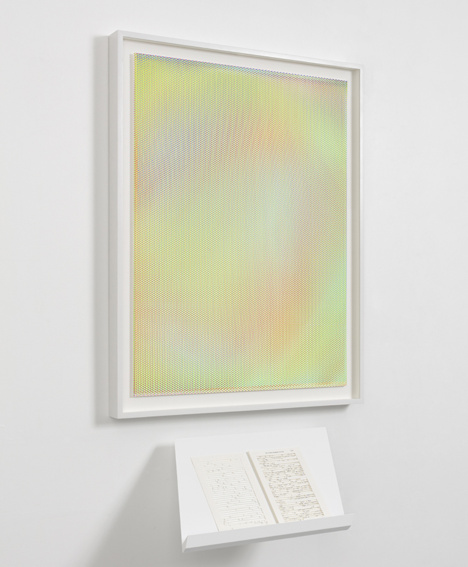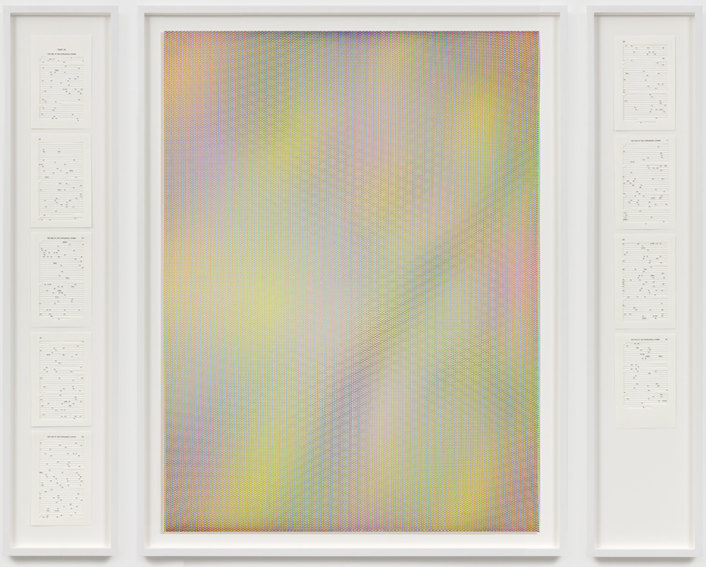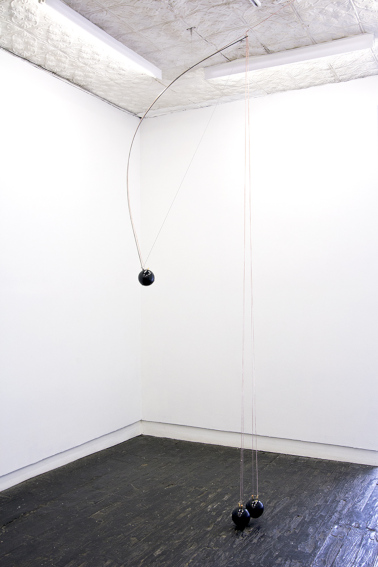
Jane Benson’s Abstract Interpretations of Suffragette Mona Caird's Revolutionary Work
When German author W.G. Sebald died in 2001, he was considered the most talented English-language author alive. The Rings of Saturn, published in 1995, was among his most beloved books. In 2017, British-born conceptual artist Jane Benson deconstructed the book with a knife, cutting away every syllable except those that belong to the musical scale: do, re, mi, fa, sol, la, si. The result, you could say, was a “literal revelation,” the unveiling of a secret musical score hidden within the text. (A sample of the “Song for Sebald” is available here.) For her latest exhibition, THE END OF THE PATRIARCHAL SYSTEM, which opened last week at LMAKgallery in New York, Benson revisits this musical editing method, mobilizing it to mine for hidden song within the writings of British suffragette Mona Caird (1854 – 1932). This time, however, Benson takes her concept to another level, translating the seven sounds of the musical scale into abstract visual compositions by corresponding them with the seven colors on the Newtonian Color Spectrum. The results are organized in the white-walled exhibition space of LMAK in an intentionally sterile way, rendering them the uncanny feel of objects on view not in an art space, but in a museum of science and history. The spectral color translations hang in white frames, flanked in some cases by the redacted texts, which are organized neatly in matching white frames. In other works, the redacted texts are presented on white shelves protruding at an angle from the wall, like an information plate explaining an ancient scroll. Meanwhile, the air is filled with the haunting sounds of American Mezzo-soprano Hai-Ting Chinn performing the musical score Benson unearthed from the texts. The sound emanates from a sculpture titled “Limited Mobility Mobile X.” Fashioned from black, circular speakers, a curved steel rod and stereo wire, the sculpture evokes visual comparisons to the Modernist language of Alexander Calder, pioneer of the mobile. The irony, though, as implied by its name, is that this mobile does not move. The curved section, evoking femininity, is sandbagged by two weighted speakers hanging in such a way that their weight rests on the floor—a testicular symbol of the stubborn inertia of the patriarchy.
Return to the Source
The works in THE END OF THE PATRIARCHAL SYSTEM are based on eight essays by Caird: The Lot of Woman under the Rule of Man, In Defence of the Wild Women, The Pioneer of Civilisation, Human Element in Man, Humanity of the Future, Patria Protestas, A Moral Renaissance, and The end of the Patriarchal System, from which the exhibition takes its name. Written more than a century ago, the essays brilliantly deconstruct the plight of women subjugated under authoritarian social structures invented and enforced by men. It is stunning to read these texts today, and to realize how relatively little progress has been made, despite certain institutional advances that have occurred in the laws of many countries. The inherent misogyny of the patriarchy is embedded not only within the laws, but within the social fabric; we can change the laws, but how do we change the hearts and minds of both men and women so radical social evolution can occur?

Jane Benson - Human Element in Man, 2019. Archival inkjet print on sintra, hand-cut on paper. 46 × 26.75 in. Edition of 2, 1 AP. LMAKgallery. Photograph by Steven Probert.
This is where the subversive elegance of this exhibition comes into play. Benson has been working for nearly 20 years with the ideas of deconstruction and re-assemblage. In “Fatigue” (2004), she deconstructed a camouflage jumpsuit then reassembled it like hanging foliage, mocking the notion of war clothes that imitate nature. For “Finding Baghdad (Part A)” (2015), she split Iraqi musical instruments in half then sent the halves to two Iraqi brothers separated after fleeing Baghdad in the early 2000s. The brothers played the modified instruments over a video conference, finding beauty in the deconstructed instruments, and discovering new layers of meaning in separation. Similarly, with this exhibition Benson draws our attention first to the deconstructed source material. Though it has been sliced to pieces, we cannot help but seek out the original essays and read them—an act we may never have done had Benson not drawn our attention to them. Yet, she also shows us how much more exists in these texts by bringing our attention to the hidden world of beauty and mystery she unearthed below the surface.

Jane Benson - THE END OF THE PATRIARCHAL SYSTEM, 2018. Hand-cut ink on paper and archival inkjet print on sintra. 53 9/16 × 75 in. Editions of 2, 1 AP. LMAKgallery. Photograph by Steven Probert.
Pushing Abstraction Forward
Another aspect of this exhibition that I find personally satisfying is the way Benson moves contemporary abstraction forward with her chromatic interpretations of the text. The colors are layered in interference patterns, creating what is known as a moiré effect, a phenomenon common in the visual language of Op Art. They are not abstracted from reality exactly; more like they are based on a formula derived from the deconstruction of something real. None of this is new—many abstract artists use the moiré effect, and many others deploy rational or scientific systems to guide their compositions. But the way Benson presents it is novel. Most process painters rely on predefined systems to control their compositions so they can take the hand of the artist out of the work. They hide their individual nature behind the process. Benson does the opposite.

Jane Benson - Limited Mobility Mobile X, 2019. Steel rod, steel wire, stereo wire, speaker, and amplifier. 115 × 32 1/2 × 4 in (292.1 × 82.6 × 10.2 cm). LMAKgallery. Photograph by Steven Probert.
She shares the intricate details of her process freely, and does not hide the fact that the process guided the outcome of the work, but presents the work in a way that definitively shows her hand and her personality. She takes the anonymity and coldness out of process-based abstraction and instead combines it with a sort of socially relevant expressionism. There is also something pleasantly Post Modern about the earnestness with which she signals how much there is to be done with the aesthetic positions of the past. When combined with the humor and whimsy of the work—especially “Limited Mobility Mobile X”—her efforts in this exhibition leave me optimistic about the future of abstraction and the end of the patriarchal system alike. THE END OF THE PATRIARCHAL SYSTEM is on view through 16 June 2019 at LMAKgallery in New York.
Featured image: Jane Benson - IN DEFENCE OF THE WILD WOMEN, 2018. Hand-cut ink on paper and archival inkjet print on sintra. 53 9/16 × 75 in. Editions of 2, 1 AP. LMAKgallery. Photograph by Steven Probert.
All images used for illustrative purposes only
By Phillip Barcio






